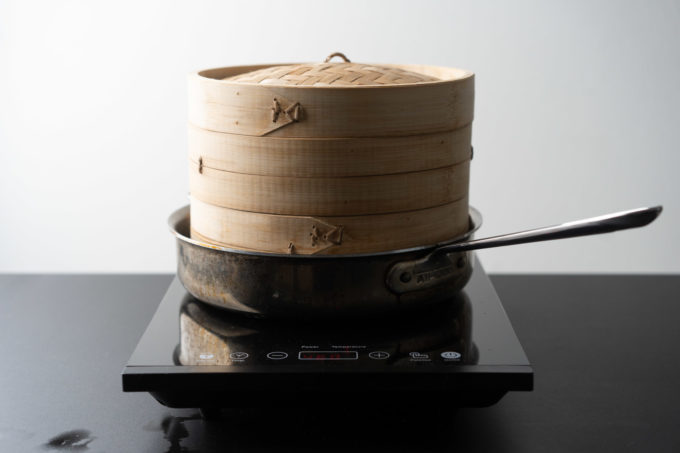
Steaming is a frequently overlooked cooking technique. It is a cooking method that uses moist heat, by which water is brought to a boil and turns into steam, transferring heat to the food and cooking it. Steaming is a great way to make delicious and healthy dishes since you don’t need to use oil to help cook the food.
Cooking Asian food in this way is a centuries-old tradition and one of the most revered methods. Bamboo steamers have been used in Asian cuisine for centuries to cook vegetables, fish, and various other dishes due to their versatility. In addition, it is an inexpensive kitchen gadget that is easy to use.
Bamboo steamer materials & construction
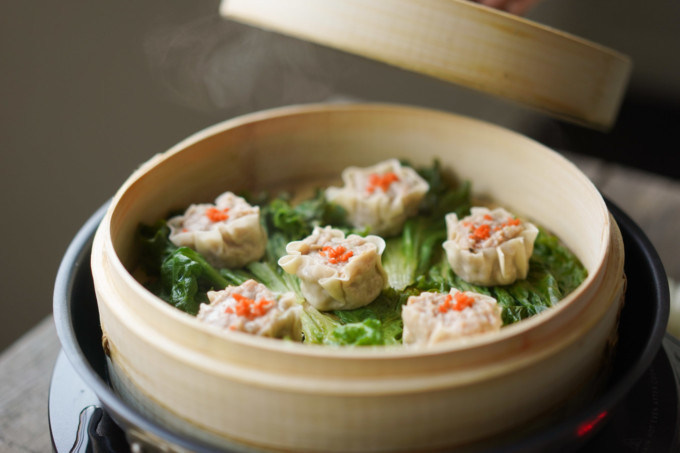
Bamboo steamers are round and typically made up of two or three steamer baskets. They have a flat top and bottom so that multiple steamer baskets can be stacked on top to allow you to cook different or multiple batches at the same time.
In contrast to the more modern metal and plastic steaming tools on the market today, a bamboo steamer is lightweight and made of all-natural bamboo material.
Nowadays, you can find them in various designs and materials. Metal bands around the edges of the steamers are now readily available for sale. With the bands wrapping around the baskets, it is more stable and less likely to break.
Cooking with bamboo steamers
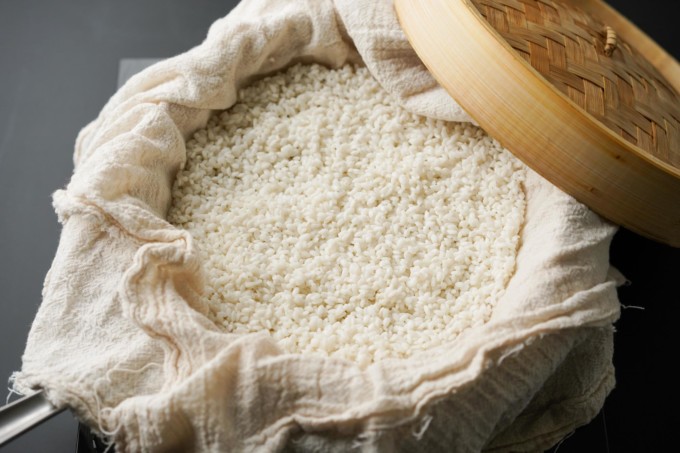
You can make many recipes in a steamer basket, including dumplings, seafood, poultry, bread, rice or sticky rice, and much more. A bamboo steamer works by placing the food in the basket, usually lined with parchment paper or cabbage leaves, and then placing the basket inside a pot with about 1 or 1 1/2 inches of water that has already been steaming. The steam can pass through the lattice of woven bamboo strips on the bottom of the baskets and cook the food inside.
Equipment needed to use a bamboo steamer
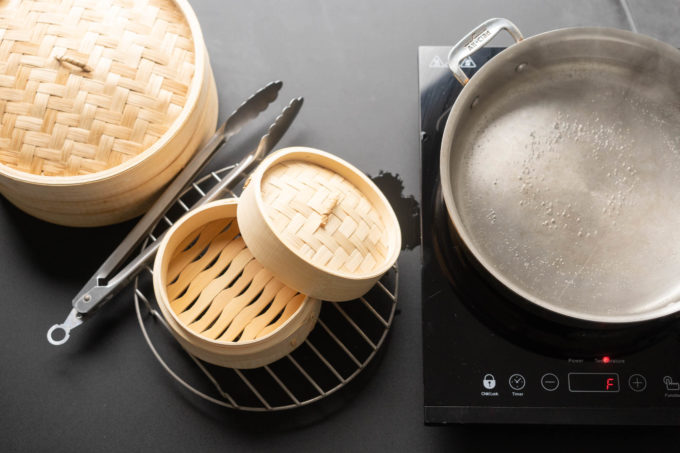
If you’re wondering, “Can you use a bamboo steamer over a saucepan?” The answer is yes. In fact, there are various kitchen tools you can use together with a bamboo steamer. So, if you are interested in trying to cook with a bamboo steamer, here are tools you might find helpful.
Pot – you can use nonstick, stainless steel, or even an enamel pot with a bamboo steamer. Do not overfill it with water as you don’t want water to get inside the food once it starts boiling.
Saucepan – a nonstick or stainless steel saucepan will work as long as the diameter of the saucepan is as big as the steamer.
Wok – this is an effective tool to use with a bamboo steamer as its sloping sides allow for the steamer to sit on the wok without needing a rack to place the steamer on. Just make sure that the steamer is smaller than the diameter of the wok.
Skillet – like a saucepan, you can use a skillet if the diameter of the skillet is at least a little larger than the steamer. Since you can only use a small amount of water when using a skillet, make sure to keep an out on the water level while steaming.
Small rack – place the rack at the bottom of the pot or pan so the bamboo steamer sits on top of it.
Tongs – makes grabbing the hot steamers easier.
Liners – parchment paper, banana leaves, lotus leaves, and cabbage leaves are just a few you can use to line the bottom and prevent food from sticking to the bottom of the steamers.
Can you steam vegetables or dumplings in a bamboo steamer?
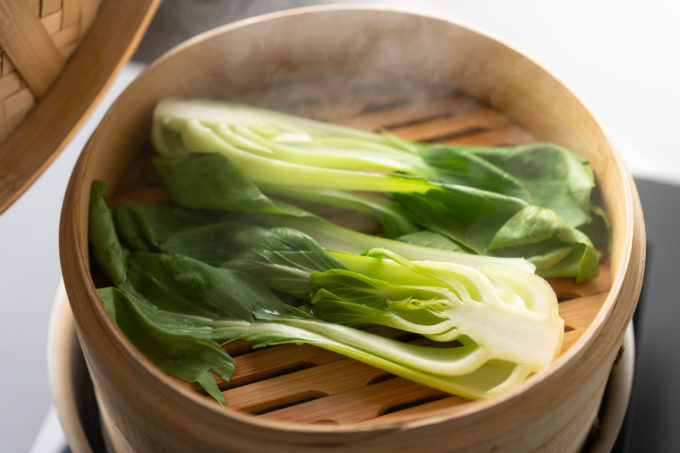
Yes, you can cook vegetables and dumplings in a bamboo steamer. This cooking method retains more flavor than any other, and it’s the best way to cook vegetables because they can retain more nutrients during the cooking process. In addition, steamed vegetables retain their vibrant color and shine as a bonus.
Place the vegetables that will take the longest to cook in the bottom basket and work your way up to the ones that will cook the fastest. Making the densest, long-cooking vegetables the first to go into the bottom tray will save you time, as will preparing the shorter-cooking vegetables for the middle and top trays.
The original method of steaming dumplings was through a bamboo steamer. Because bamboo is water-resistant, you don’t have to be concerned about condensation forming inside the steamer and making your dumplings wet and soggy. However, make sure to line the bottom of the steamer to prevent the dumplings from sticking to it.
Vegetables and dumplings aren’t the only dishes you can make with a bamboo steamer. Asian cooking traditionally uses steamers to make rice dishes, noodles, and bread since ovens were not available back in the day. Some of these recipes include cheung fun or steamed rice noodle rolls, char siu bao or steamed Chinese BBQ pork buns, and xôi lạp xưởng or Chinese sausage with sticky rice.
Your first time using a bamboo steamer
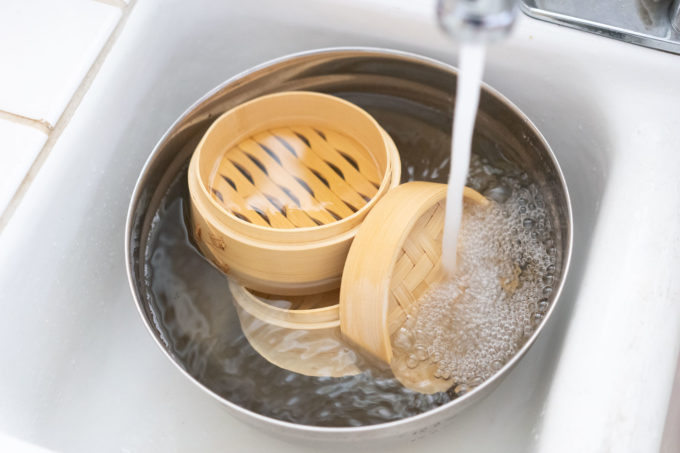
Before using your bamboo steamer, make sure it’s cleaned and treated properly. This will remove any dust from the steamer and make it more durable for steaming in the future. Follow the steps below to treat your bamboo steamer before using it for the first time:
- Wash and clean the steamer using hot, soapy water.
- Fill a pot with hot water large enough to hold the bamboo steamer, then place the steamer in the pot.
- Allow the steamer to soak for at least 8 hours or overnight. Keep in mind that some bamboo steamers may not be able to withstand soaking in hot water. Read the manufacturer’s instructions and information to determine whether soaking in hot water is appropriate for your bamboo steamer.
- Remove the steamer from the pot and allow it to dry.
- Run an oiled cloth or paper towel along the bamboo steamer’s outer and inner surfaces. You can use whatever type of cooking oil you have on hand, such as vegetable, canola, or olive oil.
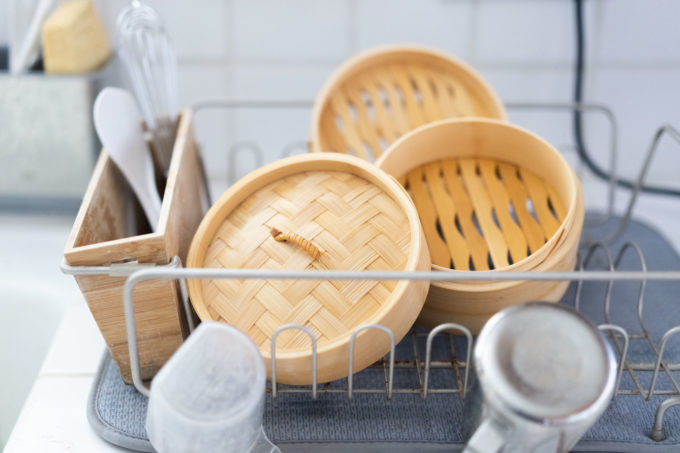
If you’re using a bamboo steamer for the first time, you may notice that it has a strong odor. It is quite normal for the bamboo steamer to smell this way due to its natural material.
There are ways to help eliminate the smell, but keep in mind that the odor may not disappear immediately the first time you treat the bamboo steamer. Additionally, the more frequently you use your bamboo steamer, the more that smell will dissipate over time.
Follow the steps below to help get rid of the odor:
- Thoroughly clean the bamboo steamer with hot, soapy water.
- Steam the steamer for about an hour or two. Continue to check to ensure that there is enough water.
- Then, soak the steamer in hot water for another 30 minutes. Check with the manufacturer’s guidelines if you can soak the bamboo steamer in water. If not, skip this step.
If the odor is still there, try these additional steps:
- Let the bamboo steamer soak in a one-to-two white vinegar and water mixture. Rinse the steamer with hot water to remove any residue.
- You can use baking soda as an alternative. Let the bamboo steamer sit for a few hours with baking soda sprinkled on it. Use hot water to rinse out and air-dry the bamboo steamer.
Steps on how to use a bamboo steamer
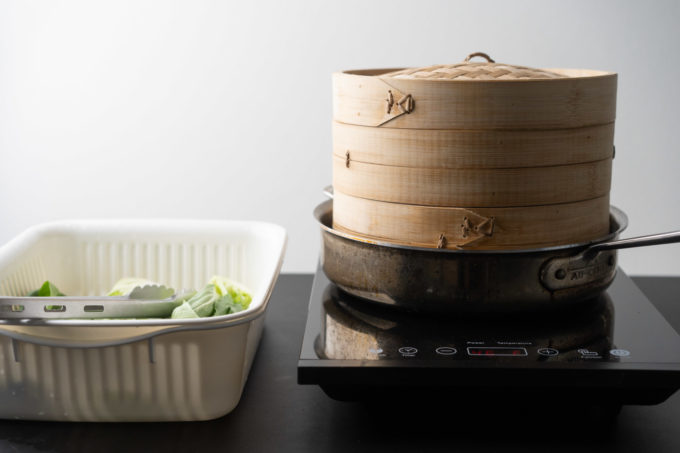
Before using your bamboo steamer, you need to make sure that you soak it for at least 20 minutes in water to prevent scorching when steaming. You also want to make sure you’ve cleaned it already to avoid contaminating the food.
- Bring a pot, saucepan, or wok with 1 inch or 1 1/2 inches of water to a boil. The water must be deep enough so that it doesn’t evaporate during cooking, but not so deep that it gets into the food while it’s boiling.
- Meanwhile, arrange the food inside the baskets. If necessary, use a heat-safe ceramic plate or line the baskets to prevent food from getting stuck at the bottom. You can also arrange the food inside the pot while the basket is inside, but be careful not to burn yourself.
- If you plan on stacking baskets, place the food that takes the longest to cook at the bottom and the food that cooks the quickest at the top.
- Keep an eye on the water to ensure it does not completely evaporate. Refill with water as needed.
- Cook until you reach desired doneness.
- Use tongs to remove the baskets safely.
How to wash and care for your bamboo steamer
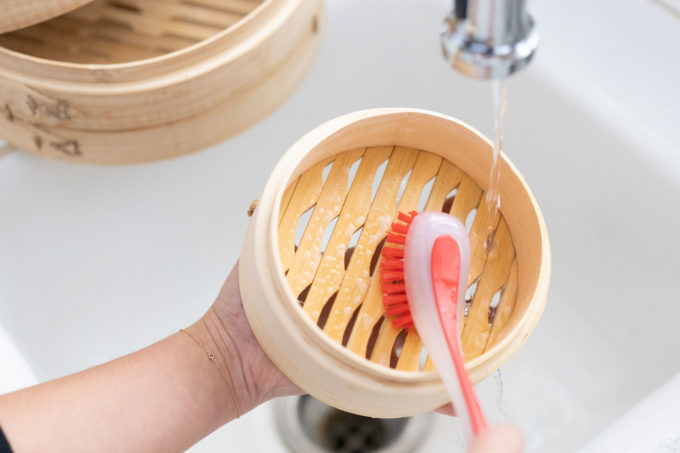
Clean the bamboo steamer after each use to remove any food that may have gotten stuck in there. To clean, follow these simple steps:
- Using mild dish soap, soak the steamer in hot, soapy water.
- Scrub the surface of baskets and lids with a soft nylon brush.
- Rinse thoroughly with hot water.
- Place the steamer on a drying rack to allow it to dry naturally.
- Let it dry completely before storing it away to prevent mold and mildew.






